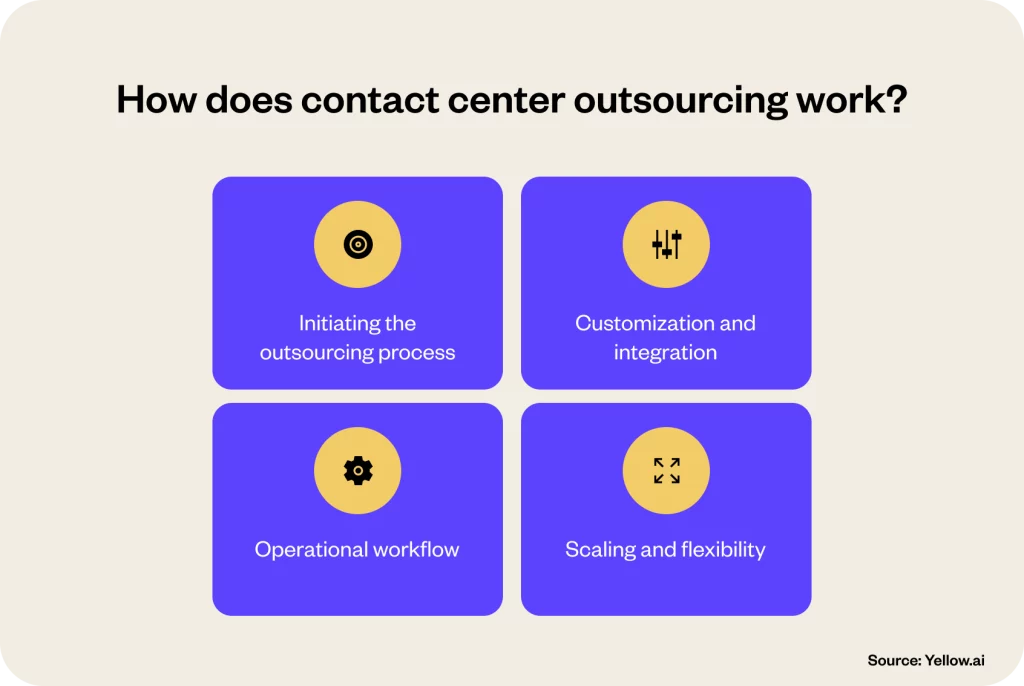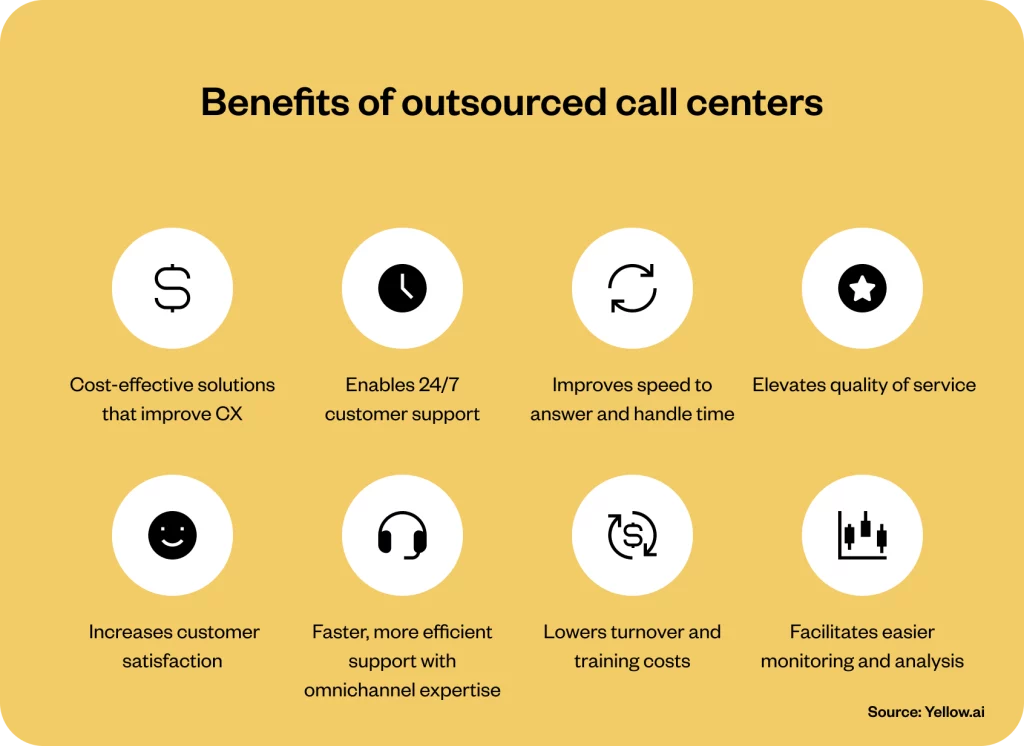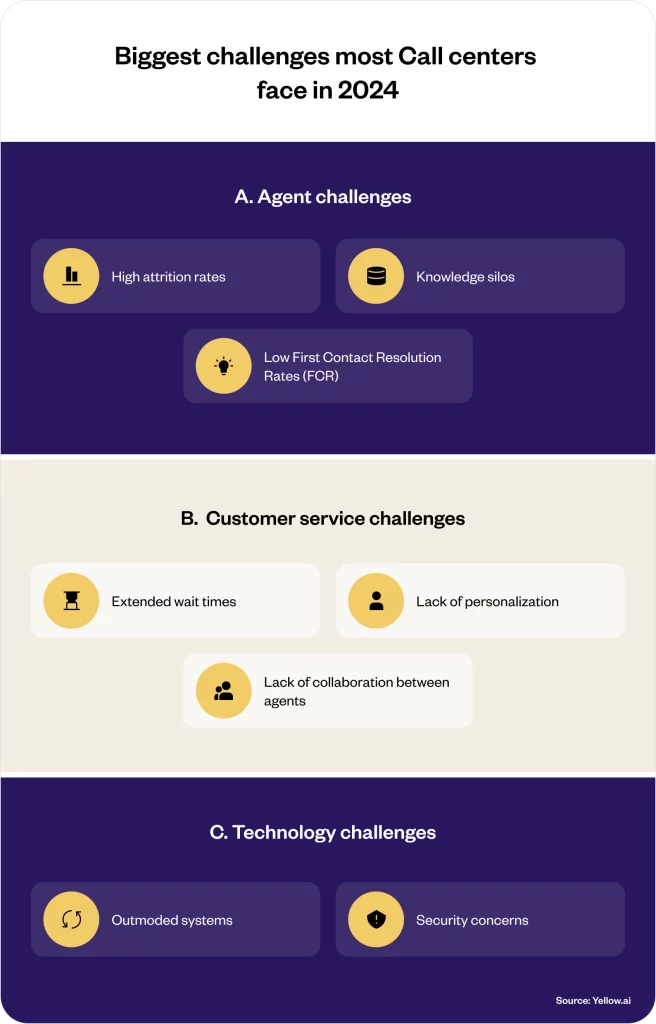Executive summary
Mastering customer support through contact center outsourcing offers a strategic edge in today’s competitive business environment. This blog explains how contact center outsourcing can transform customer experiences with cost-effective solutions, ensuring round-the-clock support and enhancing overall service quality. We explore the benefits and navigate the challenges, providing a roadmap for businesses to leverage outsourcing effectively. With insights into adopting cutting-edge technologies and best practices for engaging with outsourcing services, companies are equipped to elevate their customer service. It can drive customer satisfaction and loyalty to new heights.
Introduction
There’s a pivotal moment in every growing business’s journey when the volume of customer inquiries begins to outstrip the capacity of your in-house team. It is a sign of success but also a complex challenge. The solution? Contact center outsourcing. It is a strategy increasingly adopted by businesses ranging from sprightly startups to seasoned enterprises. By 2028, the market for such services is expected to soar to $132.92 billion, which is a testament to its growing indispensability. Outsourcing offers a lifeline, enabling businesses to scale support capabilities efficiently while maintaining a laser focus on delivering superior customer experiences.
One of the common misconceptions is that contact center outsourcing is a logistical move. However, the decision to outsource is a commitment to enhancing your customer service’s breadth and depth without the staggering overheads of expansion. Yet, it is not without its hurdles—from ensuring seamless integration with your operations to keeping the essence of your brand’s voice alive through every interaction. This narrative is not limited to just the ‘how’ of contact center outsourcing. Instead, it is a deeper dive into making it a harmonious extension of your business ethos. Read on to explore how to turn potential obstacles into stepping stones for achieving unparalleled customer service excellence.
Related must-reads:
- Omnichannel contact center: A guide for managers
- Contact center automation: Revolutionize your customer service
- Cloud contact centers: Transforming customer service
- Call center automation – Types, benefits and steps to implement
What is contact center outsourcing?
Picture this: You are running a bustling business, and the calls from customers are coming in thick and fast—so much so that your current team is swamped. It is a good problem to have because it means business is booming. But here’s the twist: you are at a crossroads where missing calls could mean missing out on growth. That is where contact center outsourcing comes in as your next strategic play. It is like calling in the cavalry; you get a team of seasoned professionals ready to take the reins of customer communication. The result? No call goes unanswered, and no query is unresolved.
Contact center outsourcing is all about teaming up with an external powerhouse dedicated to managing your customer interactions through calls, emails, chat, or social media. Think of it as passing the baton in a relay race to ensure your business keeps sprinting forward without tripping over customer service hurdles. Remember, it is not just about offloading work; it is about upgrading your customer service game. These outsourced centers are the Navy SEALs of customer service. They are equipped with the latest tech, trained in the art of customer satisfaction, and always ready to dive into action.
Why are businesses flocking to this model? It boils down to agility and expertise. Outsourcing lets you tap into a pool of experts who bring their A-game to your customer service strategy. They offer insights and innovations you might not have cooked up in-house. Plus, it’s scalable. Whether you are launching a new product or entering a busy season, your outsourced team can flex up or down, ensuring your customers always have a go-to person for their needs. In a nutshell, contact center outsourcing transforms customer service from a back-office function to a front-line growth engine. It allows you to focus on the big picture—scaling your business and enhancing your brand.
Transform your customer service today with Yellow.ai

How does contact center outsourcing work?
Navigating contact center outsourcing can sometimes feel like deciphering a complex puzzle for many businesses. The concept, while straightforward, involves layers of operations and strategic planning that can mystify even seasoned business leaders. However, understanding the mechanics behind this powerful business strategy is crucial for leveraging its full potential. Here’s a breakdown to help you understand how contact center outsourcing works, making it more approachable and relatable to businesses considering this path.

Initiating the outsourcing process
At its core, contact center outsourcing involves partnering with an external organization to handle customer communication channels on behalf of your business. This partnership can span various functions, from handling inbound customer service calls and managing outbound sales efforts to providing technical support and conducting market research.
The process begins with selecting a service provider. It is a crucial step that determines the quality and efficiency of the outsourced services. Businesses must vet potential partners carefully, considering factors like industry expertise, technology infrastructure, and alignment with the company’s customer service philosophy.
Customization and integration
A standout feature of contact center outsourcing is its adaptability to specific business needs. Once you choose a provider, the next step involves tailoring the services offered to fit the unique requirements of your business. This customization can include setting up specific protocols for inbound calls, outlining objectives for outbound marketing campaigns, or integrating the outsourced team with your existing customer relationship management (CRM) systems. The goal is to ensure that the outsourced contact center operates as a seamless extension of your business. It should preserve your brand voice and maintain the quality of customer interactions.
Operational workflow
The operational workflow of an outsourced contact center is a dance of well-coordinated activities. It leverages a mix of skilled human resources and advanced technology. Service providers employ agents trained in various aspects of customer service, from basic inquiry handling to complex technical support. It ensures a wide range of customer needs are met efficiently. These agents use state-of-the-art software and communication tools to interact with customers across multiple channels (phone, email, chat, and social media) and provide a consistent and cohesive service experience. Additionally, the outsourcing partner takes on the responsibility of monitoring service quality, managing agent performance, and continuously optimizing processes to improve customer satisfaction and operational efficiency.
Scaling and flexibility
One of the most appealing aspects of contact center outsourcing is the flexibility it offers businesses to scale their customer service operations up or down based on demand. Seasonal fluctuations, product launches, or unexpected surges in customer inquiries can be managed effectively without the need to adjust the size of an in-house team permanently. This scalability ensures that customer service quality remains high without incurring the costs and logistical challenges associated with rapid staffing changes.
8 Benefits of outsourced contact center
Diving into the realm of contact center outsourcing often conjures up questions about its tangible benefits. Beyond the apparent operational ease, it is a strategic move that offers several advantages to propel businesses forward in today’s customer-centric market. Here, we’ll explain the benefits of outsourced call centers, spotlighting how they catalyze business transformation.

1. Cost-effective solutions that improve customer experience (CX)
Maintaining an in-house call center is synonymous with high operational costs for many businesses. It can include staffing training and infrastructure. Outsourcing emerges as a cost-efficient alternative, which can significantly reduce overhead without skimping on customer experience (CX). Businesses can invest in other areas by reallocating resources typically spent on in-house operations, enhancing product development or marketing efforts. Imagine a small ecommerce platform redirecting savings into an improved online shopping experience. That will directly boost customer satisfaction and loyalty.
Related reads: How to improve customer experience? Full guide
2. Enables 24/7 customer support
In our round-the-clock economy, customers expect answers at their convenience, not just during traditional business hours. Outsourced call centers operate across various time zones, ensuring your customers receive support whenever they need it. This continuous availability can be the difference between retaining a customer and losing them to a competitor. For example, an online retailer that, by offering 24/7 support, sees a significant uptick in customer trust and repeat business, as shoppers feel valued and supported at all times.
Related read: Customer service automation – A full guide
3. Improves speed to answer and handle time
Rapid response times are crucial in today’s fast-paced market. Outsourced call centers, with their dedicated teams and streamlined processes, often outperform in-house operations in both speed to answer and handle time. This efficiency boosts customer satisfaction and also increases the volume of queries resolved, improving overall operational capacity.
4. Elevates quality of service
Outsourced call centers specialize in customer service, as they bring a wealth of experience and a focus on quality. This expertise translates into higher-quality interactions, as agents are trained to handle a wide range of scenarios with professionalism and empathy. Businesses can benefit from this specialization by aligning with outsourcing partners who share their commitment to quality.
5. Increases customer satisfaction
The ultimate goal of any customer service function is to leave the customer feeling heard, helped, and happy. Outsourced call centers excel in this domain as they are equipped with the tools and training to deliver exceptional service. The impact on customer satisfaction is immediate and measurable, often reflected in higher Net Promoter Scores (NPS) and customer retention rates.
6. Faster, more efficient support with omnichannel expertise
Today’s customers interact with businesses across multiple channels, from social media to live chat. Outsourced call centers often come equipped with omnichannel capabilities. They ensure a seamless customer experience across all platforms. This coherence in service delivery enhances efficiency and also caters to the modern customer’s expectation of integrated support.
Related read: How customer service expectations differ from generation to generation?
7. Lowers turnover and training costs
Call center work can be demanding, leading to high turnover rates in in-house operations. However, outsourced centers typically have robust recruitment, training, and retention programs in place, resulting in lower turnover. This stability within the team leads to consistent service quality and lower training costs over time. The outsourcing partner’s comprehensive agent support and development programs can lead to decreased turnovers for any organization.
8. Facilitates easier monitoring and analysis
Outsourced call centers come with advanced analytics and monitoring tools. As a result, they can provide businesses with real-time insights into service performance and customer satisfaction. This data is invaluable for continuous improvement and strategic planning. For instance, a tourism agency partnering with an outsourced call center used these insights to refine its customer service strategy. That will result in improved service delivery and increased bookings.
Biggest challenges most Call centers face in 2024
The landscape of contact center operations continues to evolve, presenting new challenges alongside opportunities for innovation and growth. Understanding these hurdles is crucial for businesses aiming to maintain high-quality customer service while navigating the complexities of modern consumer expectations and technological advancements.

A. Call centers agent challenges
1. High attrition rates
The call center industry is notoriously plagued by high attrition rates, often exceeding 40%. The root causes are multifaceted, ranging from the stress of handling difficult customer interactions to the repetitive nature of the work. It can lead to job dissatisfaction and burnout. This turnover is not just disruptive; it’s also costly, requiring constant recruitment and training of new staff.
The solution: By deploying Yellow.ai’s AI-driven chatbots and voice agents, businesses can offload routine and monotonous inquiries to bots, allowing human agents to tackle more engaging and complex customer issues. This shift can enhance job satisfaction and potentially reduce attrition rates. Furthermore, Yellow.ai’s analytics provide insights into agent performance and engagement, helping managers identify and address dissatisfaction early.
2. Knowledge silos
Agents often struggle to provide timely and accurate responses due to fragmented information spread across multiple systems. This challenge is compounded by the fast-paced nature of call center work, where quick access to comprehensive customer data is crucial for effective service.
The solution: Yellow.ai bots integrate seamlessly into existing CRM and data systems, consolidating information into a single, accessible view. It empowers agents with immediate access to the full spectrum of customer data, enabling personalized and informed interactions. Yellow.ai’s AI can also suggest responses based on historical data, further streamlining the process.
3. Low First Contact Resolution Rates (FCR)
A low First Contact Resolution (FCR) rate is often indicative of deeper issues within a contact center, such as inadequate agent training or insufficient access to information. It can lead to customer dissatisfaction, as repeated contacts for the same issue consume more time and resources, eroding trust in the brand.
The solution: Yellow.ai tackles this challenge by empowering agents with AI-assisted guidance and a comprehensive knowledge base that is accessible during customer interactions. It ensures that agents have the information and support they need to resolve issues efficiently on the first contact. Moreover, Yellow.ai’s AI can analyze interactions in real time to suggest solutions based on successful outcomes, continually improving FCR rates.
B. Customer service challenges
4. Extended wait times
A common grievance among customers is the time spent waiting to connect with an agent. Long wait times frustrate customers and can also lead to lost sales and a tarnished brand image.
The solution: Implementing Yellow.ai’s AI chatbots for initial customer interactions can drastically reduce wait times. Bots can resolve straightforward queries instantly and triage more complex issues to the appropriate human agent. That optimizes the flow of inquiries and ensures customers feel valued from the moment they reach out.
5. Lack of personalization
Personalization is key to building lasting customer relationships and loyalty. Today’s customers expect services to be tailored specifically to them. Hence, a one-size-fits-all approach falls short. Generic responses and solutions can hamper customer satisfaction and can lead to churn.
The solution: Leveraging advanced NLP and machine learning, Yellow.ai’s chatbots offer personalized interactions at scale. They remember previous conversations and preferences, adjusting their responses accordingly to deliver a customized service experience that makes customers feel recognized and appreciated.
6. Lack of collaboration between agents
Effective collaboration among agents is crucial for a consistent and unified customer experience. However, remote work environments, disparate systems, and departmental silos can hinder communication and teamwork, leading to inconsistencies in service and missed opportunities for learning and improvement.
The solution: Yellow.ai fosters collaboration through its integrated platform, which facilitates seamless communication among agents, regardless of their physical location. By centralizing customer data and interaction histories, agents can work together more effectively, sharing insights and solutions without the need for cumbersome transfers or disjointed communications.
C. Technology challenges
7. Outmoded systems
Many contact centers are hamstrung by outdated technology that cannot keep pace with the demands of modern customer service or scale with business growth. These legacy systems often lack the agility to integrate with new tools or adapt to changing customer preferences.
The solution: Yellow.ai’s cloud-based platform is scalable and also highly adaptable. It easily integrates with existing business systems and communication channels. This adaptability ensures that contact centers are equipped with the latest technology to manage customer interactions across all touchpoints efficiently.
8. Security concerns
As contact centers collect and store vast amounts of sensitive customer information, they become prime targets for cyberattacks. Ensuring data security is paramount to maintaining customer trust and compliance with regulatory requirements.
The solution: Security is a cornerstone of Yellow.ai’s platform, which uses advanced encryption and adheres to strict data protection standards to safeguard customer information. Regular security audits and compliance with global privacy laws ensure that customer data remains secure.
How Yellow.ai can help solve call center challenges and enhance customer service
Navigating the challenges of contact center outsourcing requires innovative solutions that can streamline operations, enhance customer satisfaction, and ensure seamless integration with existing systems. Yellow.ai stands at the forefront of this transformation, offering cutting-edge AI-powered products, tools, and customer service solutions that redefine how businesses engage with their customers.
For example, by deploying its AI voice agents and chatbot, you can automate the routine and tedious tasks landing at your call center. You can enhance your customer service’s reach to a global audience with Yellow.ai, as it empowers you to interact in 135+ global languages. You can also improve several critical aspects of an ideal call center service, such as FTR.
Related read: Top 10 customer service tips for 2024: Elevate your support
Features and solutions
- Natural Language Processing (NLP): Yellow.ai’s advanced NLP capabilities allow for more natural and intuitive customer interactions, as well as the ease of understanding and processing customer queries.
- Cloud-based platform: Leveraging cloud technology, Yellow.ai ensures scalable, flexible, and secure customer service solutions. The cloud infrastructure supports rapid deployment and easy integration with existing business systems, enabling businesses to adapt to changing customer service demands without significant upfront investments.
- Omnichannel capabilities: Yellow.ai offers a truly omnichannel experience, allowing customers to seamlessly transition between communication channels such as voice, chat, email, and social media while maintaining the context of their interactions. It ensures a consistent and personalized customer experience across all platforms.
- Customizable AI solutions: Yellow.ai offers customizable AI solutions tailored to specific industry needs, enhancing customer interactions and operational efficiency.
- No-code bot builders: With Yellow.ai, businesses can deploy AI chatbots without the need for extensive coding knowledge. That makes it easier to implement and customize chatbots to suit specific business needs.
- Analytics and insights: With built-in analytics, Yellow.ai provides actionable insights into customer interactions and service performance, enabling continuous improvement and strategic decision-making.
Interested in transforming your customer service?

The final thoughts
As we journey through the evolving landscape of customer service, it’s clear that contact center outsourcing is a strategic move toward operational excellence and customer satisfaction. The insights and solutions discussed offer a beacon for businesses navigating the complex currents of today’s customer service demands. With the right approach, technology, and partner, outsourcing becomes less about offloading tasks and more about empowering your business to reach new heights in customer engagement and loyalty.
Ultimately, the choice to outsource is more than a business decision—it’s a commitment to your customers and the quality of service they receive. As we look to the future, the role of technology in shaping customer experiences is undeniable. Yellow.ai stands at the forefront of this transformation, offering solutions that meet the current needs of businesses and anticipate the demands of tomorrow. Let’s embrace this future together, creating customer service experiences that are both satisfactory and genuinely remarkable.
Frequently asked questions (FAQs)
How do we choose the right contact center outsourcing partner?
Choosing the right contact center outsourcing partner involves evaluating their technological capabilities, industry experience, language support, and scalability. Look for partners with a proven track record of delivering high-quality customer service and the ability to integrate with your existing systems. Transparency, flexibility, and a commitment to security and data protection are also critical factors to consider.
What are the typical costs involved in contact center outsourcing?
Figuring out how much you’ll spend on outsourcing your contact center operations isn’t a one-size-fits-all answer. It hinges on what you need to be done, how many calls or interactions they’ll be handling, and the skill level of the folks you’re hiring. You might be billed by the hour for each agent, or you might strike a deal for a set amount each month or year. What’s crucial is looking beyond the immediate price tag to the bigger picture—like how much you’ll save on not having to manage a big team in-house or the tech and office space you won’t need to fork out for.
How can we ensure quality and consistency in customer service when outsourcing?
Ensuring quality and consistency involves regular monitoring and evaluation of the outsourcing partner’s performance, setting clear service level agreements (SLAs), and maintaining open lines of communication. Implementing a robust quality assurance program and leveraging technology for real-time feedback and analytics can also help maintain high service standards.
What are the 4 elements of a contact center?
The four essential elements of a contact center are people (agents and support staff), processes (protocols and workflows for handling customer interactions), technology (software and tools for communication and management), and strategy (overall approach to customer service, including objectives and metrics).
What is an example of a contact center service?
An example of a contact center service is technical support, where customers can contact the center via phone, email, or chat to get assistance with product issues, setup help, or troubleshooting. This service typically involves specialized agents trained to resolve technical queries efficiently.






















